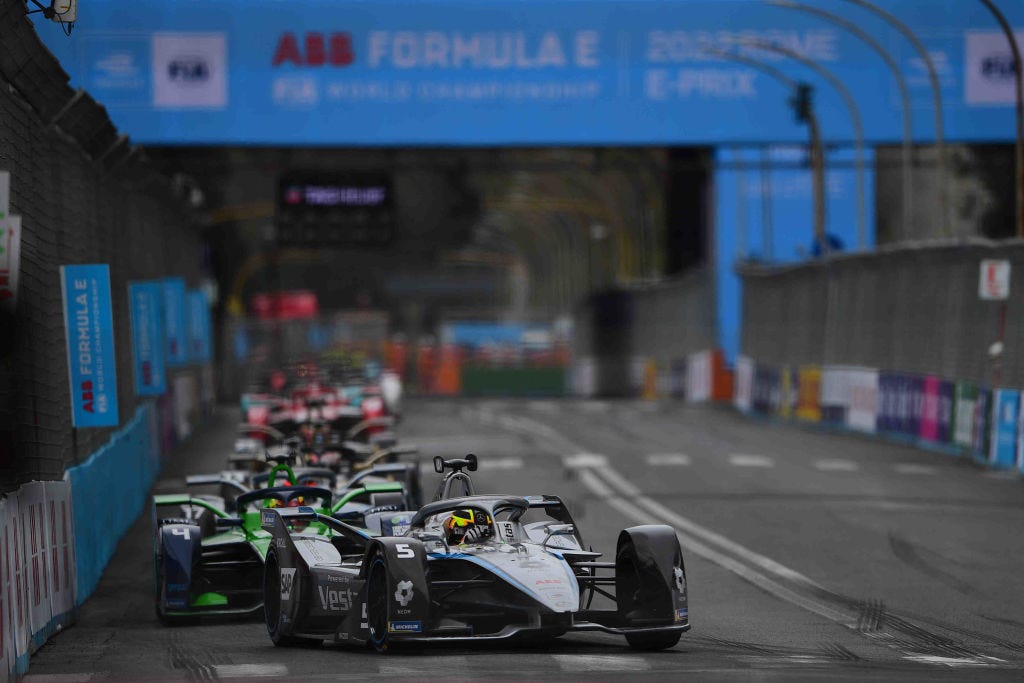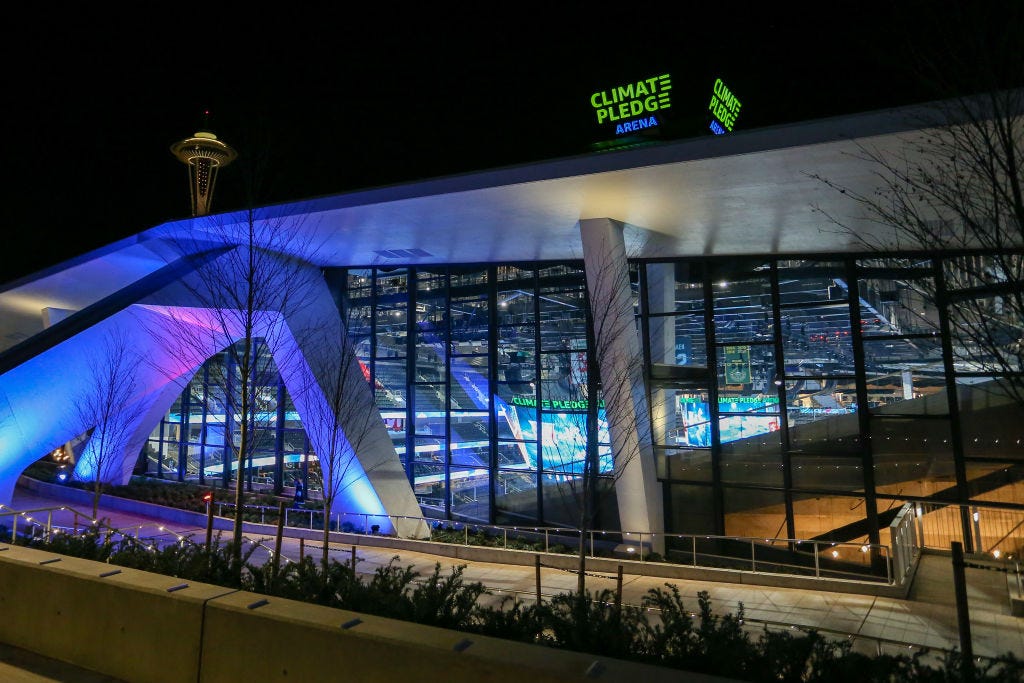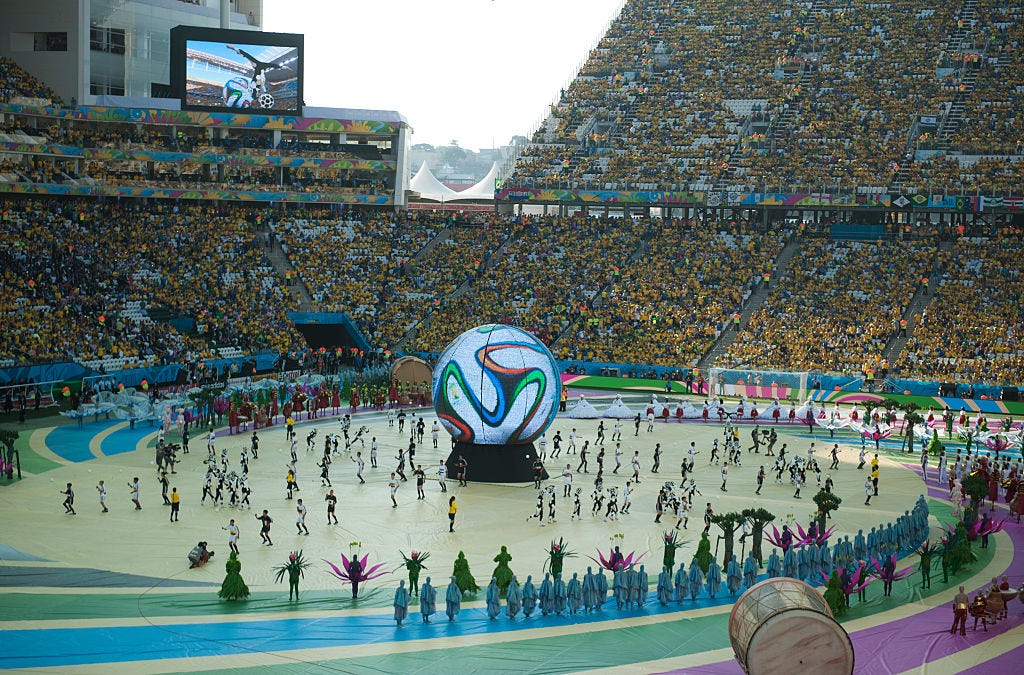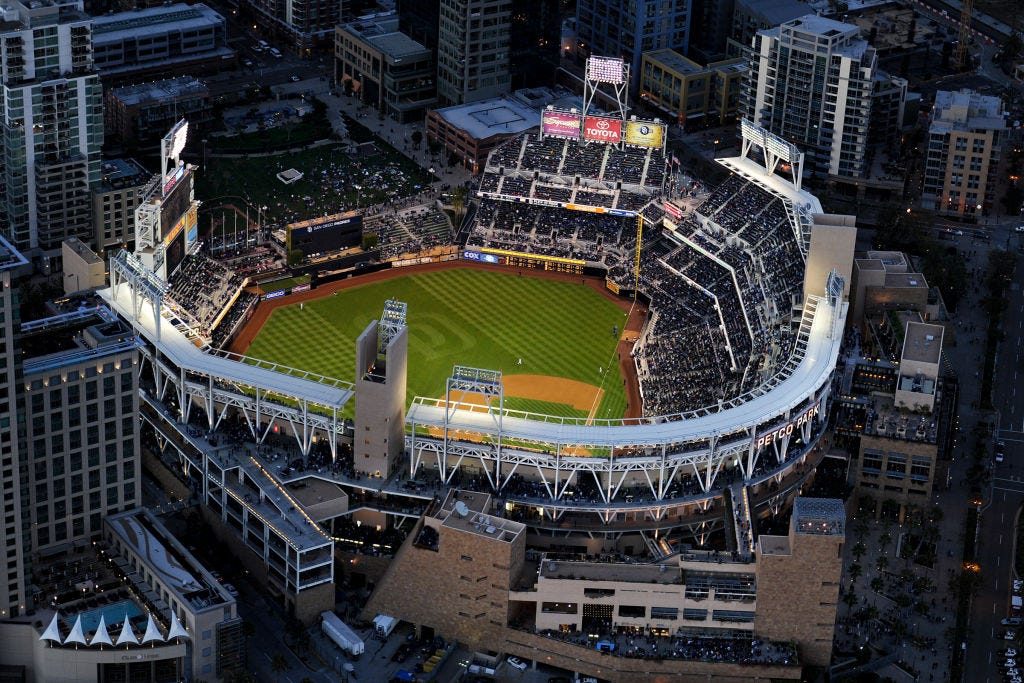Global Sport Matters: The Sustainability of Sport Issue (Part II)
Auto racing's electric future, the Seattle arena trying to set a green bar, how to spot sports "greenwashing," environmental justice in sports, and how stadiums can support sustainable development.
Welcome to Hreal Sports, a newsletter written by Patrick Hruby about sports things that don’t stick to sports. Sign up and tell your friends!
Hello again! Ongoing apologies for ghosting your inbox last month: I was dealing with a family illness, and some things had to give.
That said, I’m thrilled to share the second batch of stories for the April issue of Global Sport Matters, the digital publication of the Global Sport Institute at Arizona State University. For those of you who are unfamiliar with our work, we cover a wide range of outside the lines, sports and society topics though original research and reporting, and via podcasts, live events, standalone articles, and monthly themed issues.
April is all about the Sustainability of Sports. Maybe you’ve heard: thanks to humanity’s habit of pumping carbon dioxide and other greenhouse gasses into the Earth’s atmosphere, the Planet Is Getting Too Damn Hot. So how is climate change already impacting sports across the globe? What will our even-warmer future look like? What role can sports play in reducing carbon emissions (and other forms of pollution) in order to prevent worst-case warming scenarios from becoming reality?
Our issue is devoted to answers. Links and summaries are below for stories on auto racing's electric future, the Seattle arena trying to set a green bar, how to spot sports "greenwashing," environmental justice in sports, and how stadiums can support sustainable development. Hope you enjoy—and in case you missed it, click here to see Part I!
“Not So Fast: The Electric Future of Auto Racing Will Look, Sound and Feel Different,” by Matt Crossman.
The electrification of America’s cars is the emphasis of climate activists, the White House, and just about every major manufacturer, creating pressure on auto racing leagues to get with the times. So how close is the famously loud and gas-propelled sport to a cleaner, quieter future—and what obstacles still stand in the way?
Right now, many racing fans simply wouldn’t accept motorsports abandoning ICEs in favor of EVs. High on the list of reasons is that the race-day experience would be dramatically altered.
Attending an auto race is a full-body, sensory-overload experience, far more than any other sport. The sight of brightly colored cars inches away from one another barreling around corners at 200 mph is breathtaking. The smell of the garage – oil, gas, and, if you get too close to the mechanics, sweat – occurs there and only there.
Oh, and the sound!
Imagine 40 lions, each the size of a Winnebago, roaring into a microphone piped into your tiny bedroom, which is also an echo chamber, and have it last three and a half hours, and you get an inkling of what it’s like to attend a NASCAR Cup Series race. With open-wheel racing such as F1, IndyCar, and sprint cars, imagine “Flight of the Bumblebee,” only it’s played by Metallica when they’re ferociously pissed off and your head is crammed inside the amplifier.
And you don’t just hear the noise. You feel it. At NHRA events, the 11,000-horsepower going from the engine to the ground and propelling the car at 330 miles per hour in 3.5 seconds creates a concussion in the air. It hits your ribs, rattles your lungs, and goes out your back.
Take away the noise, and to a lesser degree the smell of gas and oil (the sweat will always be there), and attending an EV race will be vastly different – less visceral, less aggressive, less in your face. It might sound silly to a non-racing fan, but I promise you, it’s not. It’s a version of the same issue racing faces with every major change: We like the old way, so leave us alone – unless the new way will be better, faster, and racier, and then maybe.
“Seattle’s Climate Pledge Arena Wants to Set a ‘New Sustainability Bar for Sports.’ Can it Succeed?” by Neil deMause.
The sports industry is beginning to reinvent itself with more sustainable business practices, and Climate Pledge Arena, home of the Seattle Kraken and Storm, has tried to use a sponsorship from Amazon to blaze a carbon-neutral trail in sport. How close is the arena to its net-zero carbon emissions goal?
But a building’s carbon footprint doesn’t stop with keeping its lights and video boards on. Nor does it end on the host teams’ off nights. “When (rapper) Tyler, the Creator comes on Friday, we need to account for the 25 vehicles that come along with his tour: 18 semi trucks and seven tour buses,” Johnson said. “Then, we need to account for the travel behavior of the 17,000 fans that are coming to see Tyler, the Creator. And we do account for the carbon footprint of the food that’s consumed at the building,” as well as beverage and souvenir sales and staff travel.
There’s also the footprint of the arena itself. For the Climate Pledge Arena renovation, this involved an almost complete rebuild under its existing (and historic) roof. That amounted to 35,000 tons of carbon, according to Johnson — lower than it would have been if the arena’s roof hadn’t been reused, but still as much as driving about 7,500 cars for a year.
To calculate the building’s entire carbon footprint, Johnson said, the arena operators have constructed an enormous database — hosted, not surprisingly, by Amazon Web Services. “In late spring, early summer of this year, we will start with a public-facing dashboard component,” he added. “And then at the conclusion of the first year of operations, so October of 2022, we will be able to say, ‘We believe the carbon footprint of the building was X, and we’re making investments in Y’ that equal or exceed the building’s total emissions. Those investments will come in the form of more carbon offset purchases."
It’s an ambitious goal, and one that Barbara Haya, director of the Berkeley Carbon Trading Project at University of California-Berkeley, said is deserving of praise. “The things that really excite me from this is that they’re going to be 100% renewable energy from plants that they helped build themselves; that they’re zero waste, zero single-use plastics,” Haya said. “It’s really good to see these direct reductions in their impact.”
“Sports Aren’t Immune From ‘Greenwashing.’ Here’s How To Spot It,” by Natasha Brison.
Sports organizations are savvy at using the thrill and community of sport to water down the unsavory parts of the business. ‘Greenwashing’—that is, pretending to provide environmental benefits when you actually do not—has become the latest attempt by sport to embellish its image.
Greenwashing usually occurs when a company:
Uses confusing or misleading language in its advertising.
Omits information regarding the environmental impact of its production processes.
Fails to substantiate and/or verify its environmental claims.
Mixes and matches all of the above.
For an example outside of sports, consider the automobile manufacturer Hyundai, which in the United Kingdom advertised its NEXO fuel cell vehicle as “a car so beautifully clean, it purifies the air as it goes.” As a hydrogen-powered car that produces its own electricity by combining oxygen and hydrogen within a fuel cell, the NEXO does not release exhaust fumes like a traditional combustion engine. Moreover, it does have an air filter that removes fine dust and gasses before they reach its fuel cell. However, the U.K.’s advertising regulatory body still banned the ad because the NEXO does emit particulates from brake and tire wear that are a significant source of air pollution.
Similarly, Adidas launched a sustainability campaign in March 2021 with Kermit the Frog and former tennis player Stan Smith to promote its efforts of going green with the Adidas Originals line of sneakers. The line used Adidas’ Primegreen material made from 50 percent recyclables, along with a recycled rubber sole. The shoe also included a logo including the text “End Plastic Waste.” The campaign promoted Adidas’ commitment to eliminate its plastic waste and its goal to use 100 percent recycled polyester in their products by 2024.
All of this appeared to be a positive step for the company, which has a sustainability statement focused on making products that are good for athletes as well as the planet. Last September, however, France’s advertising ethics professional regulatory agency, the Jury de Déontologie Publicitaire (JDP), ruled that Adidas’ advertisement for the Stan Smith sneaker violated advertising rules and was misleading to consumers.
“Why the Impact of Climate Change on Sport Is an Environmental Justice Problem,” by Jessica Murfree.
Issues of access and health in sport are being exacerbated by climate change, making clean air at outdoor fields, safe playing surfaces, and comfortable temperatures a matter of environmental justice in sport.
Historically, Black and Brown communities in the U.S. have suffered sports-related environmental injustices. For example, these communities have had limited access to safe, affordable, well-lit, and well-maintained bike paths and swimming pools when compared to traditionally White communities – all of which puts these minority communities at greater risk of harm. From 2016 to 2018, Black and Latinx Americans took 18 percent of bike trips but suffered 31 percent of all cycling fatalities. Similarly, Indigenous and Black Americans suffer drowning deaths at rates twice as high as White Americans. These examples highlight inaccessibility related to sport, recreation, and environmental injustice.
Climate change figures to exacerbate these inequities.
Conditions such as extreme heat and weather, severe storms, and disappearing snow create additional opportunities for marginalized communities to be disadvantaged – widening the gap between society’s haves and have-nots, particularly when it comes to accessing sports in the first place. Consider skiing and snowboarding. Professional athletes in both sports, who have money and opportunities to participate, are losing access because of climate change. Elite competitors have to travel further and to higher altitudes to keep practicing and competing; the current alternative to this, artificial snow, is also expensive. As costs rise, resort-based winter sports that already are disproportionately wealthy and White could become even less diverse.
Golf faces a similar problem. Historically, the sport has been inaccessible to women, people of color, and low-income groups. As the climate changes, golf courses will be challenged by drought, rising sea levels, more severe storms, and hotter temperatures – and as solutions to those issues raise operating costs, the sport will also be challenged to remain accessible for all. The city of Minneapolis, Minnesota, has become a hub for the most recent systemic racism social justice movement following the murders of Philando Castile, George Floyd and Daunte Wright. As a result, dozens of grassroots efforts for justice have made their home in the Twin Cities. For golf, which largely remained segregated long after the Jim Crow era, Minnesotans are finally reckoning with the institutional racism in their area and how that has affected sport opportunity for Black people. Climate change is wreaking havoc on golf equity in Minneapolis as lower-income, predominantly-minority parks and courses are flooding and struggling to recover.
“Impactful, Livable, Accessible: Three Ways Sports Stadiums Can Support Sustainable Urban Development,” by Stephanie Gerretsen.
In many cities, nothing stands more prominently on the skyline than sports stadiums. They are major parts of the community, giving them an exceedingly important role in the sustainable development of the places they reside.
Professional sports facilities have a relatively short lifespan, with many demolished after 30 years or less. They typically are built through public funding that otherwise might be used to address arguably more urgent and important civic needs, such as providing greater access to health care or improving public schools. They can be engines of urban gentrification, driving up property values while driving out longtime residents. And they seldom engender broad and egalitarian public participation, instead tending to host expensive games and events attended by wealthy elites while leaving less affluent people on the outside looking in.
For all of these reasons and more, large sports infrastructure development projects such as stadiums, ballparks, and arenas can be the antithesis of sustainable community development – that is, development which protects the natural environment and green spaces, promotes economic growth, and enhances social justice and equity.
Urban planners will tell you that these three goals often conflict with each other. Meanwhile, the long and well-studied history of sports facility development suggests that stadium construction is an especially difficult way to pursue them. However, that’s no reason for governments – such as those in New York, where state and local officials recently announced plans to contribute a record $850 million in taxpayer money toward the construction of a new National Football League stadium – to not try to make sports development more sustainable. With foresight, willpower, and the ability to imagine what stadiums can be used for beyond hosting teams and events, good things are possible.
This has been Hreal Sports, a newsletter written by Patrick Hruby about sports things that don’t stick to sports. If you have any questions or feedback, contact me at my website, www.patrickhruby.net. And if you enjoyed this, please sign up and share with your friends.









